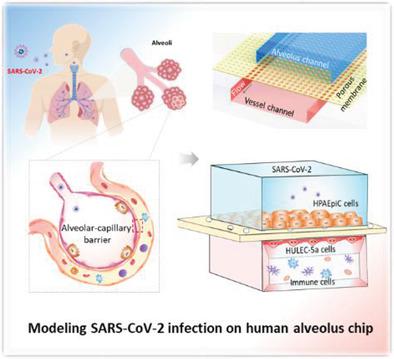Our official English website, www.x-mol.net, welcomes your
feedback! (Note: you will need to create a separate account there.)
Biomimetic Human Disease Model of SARS‐CoV‐2‐Induced Lung Injury and Immune Responses on Organ Chip System
Advanced Science ( IF 14.3 ) Pub Date : 2020-10-24 , DOI: 10.1002/advs.202002928 Min Zhang 1, 2 , Peng Wang 1 , Ronghua Luo 3, 4, 5 , Yaqing Wang 1, 2 , Zhongyu Li 1 , Yaqiong Guo 1, 2 , Yulin Yao 4, 6 , Minghua Li 3 , Tingting Tao 1, 2 , Wenwen Chen 1, 2 , Jianbao Han 3 , Haitao Liu 1, 2 , Kangli Cui 1, 2 , Xu Zhang 1 , Yongtang Zheng 3, 4, 5 , Jianhua Qin 1, 2, 7, 8
Advanced Science ( IF 14.3 ) Pub Date : 2020-10-24 , DOI: 10.1002/advs.202002928 Min Zhang 1, 2 , Peng Wang 1 , Ronghua Luo 3, 4, 5 , Yaqing Wang 1, 2 , Zhongyu Li 1 , Yaqiong Guo 1, 2 , Yulin Yao 4, 6 , Minghua Li 3 , Tingting Tao 1, 2 , Wenwen Chen 1, 2 , Jianbao Han 3 , Haitao Liu 1, 2 , Kangli Cui 1, 2 , Xu Zhang 1 , Yongtang Zheng 3, 4, 5 , Jianhua Qin 1, 2, 7, 8
Affiliation

|
Coronavirus disease 2019 (COVID‐19) is a global pandemic caused by severe acute respiratory syndrome coronavirus 2 (SARS‐CoV‐2). The models that can accurately resemble human‐relevant responses to viral infection are lacking. Here, a biomimetic human disease model on chip that allows to recapitulate lung injury and immune responses induced by SARS‐CoV‐2 in vitro at organ level is created. This human alveolar chip reproduce the key features of alveolar‐capillary barrier by coculture of human alveolar epithelium, microvascular endothelium, and circulating immune cells under fluidic flow in normal and disease. Upon SARS‐CoV‐2 infection, the epithelium exhibits higher susceptibility to virus than endothelium. Transcriptional analyses show activated innate immune responses in epithelium and cytokine‐dependent pathways in endothelium at day 3 post‐infection, revealing the distinctive responses in different cell types. Notably, viral infection causes the immune cell recruitment, endothelium detachment, and increased inflammatory cytokines release, suggesting the crucial role of immune cells involved in alveolar barrier injury and exacerbated inflammation. Treatment with remdesivir can inhibit viral replication and alleviate barrier disruption on chip. This organ chip model can closely mirror human‐relevant responses to SARS‐CoV‐2 infection, which is difficult to be achieved by in vitro models, providing a unique platform for COVID‐19 research and drug development.
中文翻译:

器官芯片系统上 SARS-CoV-2 引起的肺损伤和免疫反应的仿生人类疾病模型
2019 年冠状病毒病 (COVID-19) 是由严重急性呼吸综合征冠状病毒 2 (SARS-CoV-2) 引起的全球大流行。目前缺乏能够准确模拟人类对病毒感染的相关反应的模型。在这里,创建了一种芯片上的仿生人类疾病模型,可以在器官水平上重现 SARS-CoV-2 体外诱导的肺损伤和免疫反应。这种人类肺泡芯片通过在正常和疾病的流体流动下共培养人类肺泡上皮、微血管内皮和循环免疫细胞,再现了肺泡毛细血管屏障的关键特征。感染 SARS-CoV-2 后,上皮细胞对病毒的敏感性高于内皮细胞。转录分析显示,感染后第 3 天,上皮细胞中的先天免疫反应和内皮细胞中的细胞因子依赖性途径被激活,揭示了不同细胞类型的独特反应。值得注意的是,病毒感染导致免疫细胞募集、内皮脱落和炎症细胞因子释放增加,这表明免疫细胞在肺泡屏障损伤和炎症加剧中发挥着至关重要的作用。瑞德西韦治疗可以抑制病毒复制并减轻芯片上屏障的破坏。该器官芯片模型可以密切反映人类对 SARS-CoV-2 感染的相关反应,这是体外模型难以实现的,为 COVID-19 研究和药物开发提供了独特的平台。
更新日期:2020-10-24
中文翻译:

器官芯片系统上 SARS-CoV-2 引起的肺损伤和免疫反应的仿生人类疾病模型
2019 年冠状病毒病 (COVID-19) 是由严重急性呼吸综合征冠状病毒 2 (SARS-CoV-2) 引起的全球大流行。目前缺乏能够准确模拟人类对病毒感染的相关反应的模型。在这里,创建了一种芯片上的仿生人类疾病模型,可以在器官水平上重现 SARS-CoV-2 体外诱导的肺损伤和免疫反应。这种人类肺泡芯片通过在正常和疾病的流体流动下共培养人类肺泡上皮、微血管内皮和循环免疫细胞,再现了肺泡毛细血管屏障的关键特征。感染 SARS-CoV-2 后,上皮细胞对病毒的敏感性高于内皮细胞。转录分析显示,感染后第 3 天,上皮细胞中的先天免疫反应和内皮细胞中的细胞因子依赖性途径被激活,揭示了不同细胞类型的独特反应。值得注意的是,病毒感染导致免疫细胞募集、内皮脱落和炎症细胞因子释放增加,这表明免疫细胞在肺泡屏障损伤和炎症加剧中发挥着至关重要的作用。瑞德西韦治疗可以抑制病毒复制并减轻芯片上屏障的破坏。该器官芯片模型可以密切反映人类对 SARS-CoV-2 感染的相关反应,这是体外模型难以实现的,为 COVID-19 研究和药物开发提供了独特的平台。











































 京公网安备 11010802027423号
京公网安备 11010802027423号